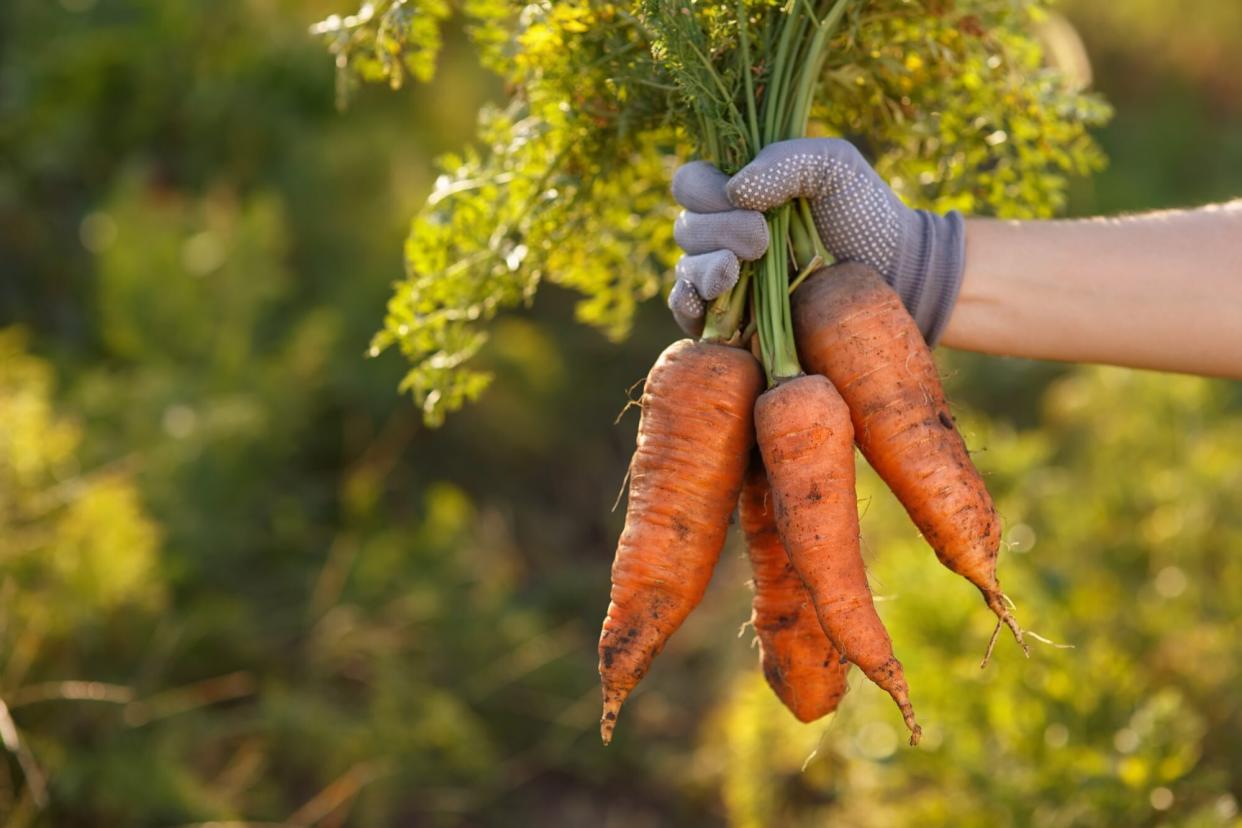How To Grow Carrots In Your Garden

Alter_photo/Getty Images
TABLE OF CONTENTS
On This Page
When To Plant Carrots
What Kind of Carrots Should I Plant?
How To Plant Carrots
Do Carrots Need Fertilizer?
When To Thin Carrots
How To Harvest Carrots
The snap of a juicy carrot fresh from your own backyard is worth the bit of extra effort required to grow these vegetables successfully. "Carrots are one of the more finicky crops to get established," says Wesley Palmer, Southeastern territory sales representative for Johnny's Selected Seeds. "They take from one to three weeks to pop up, they don't germinate as easily as other crops such as radishes or beans, and they have a long growing season."
Another challenge is that carrots have a low germination rate, which is how many of the seeds you plant actually sprout. It's typically around 80 percent or lower, meaning 80 out of 100 seeds germinate. Because they're so fussy, it's smart to buy new carrot seeds annually to increase your odds of success. The seeds also are tiny, so some companies sell pelleted seed, which is coated in a thin layer of clay, to make uniform spacing when sowing easier, says Palmer.
Here's what else you need to know to grow carrots:
When To Plant Carrots
Carrots germinate when soil temperatures are between 50 to 85 degrees, so you have two windows for planting: Spring and fall. Fall is actually the ideal time in the South because carrots planted in the spring may bolt, or go to seed, as a result of complex factors including the number of daylight hours and day-to-night temperature fluctuations, says Palmer.
In most of the south, you can plant from March to April and from July to September; but in the Lower South, you can sow carrot seeds from September until March. Sometimes when you plant in the fall, the seedlings pop up, then they don't do much until spring when they kick into high gear again; these carrots, which have overwintered, tend to be the sweetest, says Palmer.
What Kind of Carrots Should I Plant?
Great options for the South include Yaya, which is mild and crisp with a compact top; Mokum, which is a slender carrot that holds its sweetness even in hot weather; Romance, which is sweet with good disease resistance; and Bolero, which is reliable and stores for months, says Palmer. For a carrot that overwinters well and becomes sweeter after cold exposure, opt for Napoli.
How To Plant Carrots
Carrots need full sun, which is considered 6 or more hours of direct sunlight per day. Although you can grow carrots in containers at least 12 inches deep, it's not recommended. The results will be lackluster. Instead, seed directly into the ground or in raised beds, says Palmer.
Carrots grow best in loose, fertile, sandy loam, not red clay, says Palmer. But if you have soil that's concrete-like, work on improving its texture by tilling in compost to a depth of 10 inches with a tiller or garden fork and rake. It's also a good idea to contact your local university coop extension service (find yours here) for soil testing and other regional growing advice.
Once your bed is ready, make a furrow about ¼-inch deep, and sprinkle the seeds down the row. Overseed heavily to get a good germination rate. Brush soil lightly over the top of the seeds, then press down firmly with your hand to ensure seed-to-soil contact, says Palmer. Place rows about a foot apart.
Keep seeds lightly moist. Once seedlings appear, continue to keep them moist for another few weeks. "They need the most water as they're getting established," says Palmer. "Water deeply and less frequently so that water penetrates to the roots, not just the surface. Stick a finger in to see if it feels wet a few inches down."
Do Carrots Need Fertilizer?
It's not absolutely necessary to fertilize carrots because they're not heavy feeders like tomatoes or corn. Amending the soil with compost at the beginning of the season is usually sufficient. However, it's okay to feed a water-soluble fertilizer once during the season. But don't overdo it because too much nitrogen creates lots of top growth and not enough root growth, says Palmer.
When To Thin Carrots
It feels a little unkind, but you've got to cut down on competition among the seedlings. Thin seedlings once their first leaves appear, which is when they're roughly an inch tall. "When you get the proper spacing early, they'll grow more vigorously," says Palmer. Use your fingers to pinch and pull up on a few baby plants at a time, spacing to about one-inch between plants. Yes, it's tedious but necessary! Also, make sure to keep the area weeded.
How To Harvest Carrots
Carrots mature 55 to 80 days after they break through the soil; keep your seed package and jot down germination date, so you'll have an idea of when they'll be ready. Harvest when the crown of top of the carrot is slightly visible above the soil, says Palmer. Use a garden fork to loosen and lift each plant. If you're unsure they're ready, pull one up to check on progress. Rinse well, let dry, then store in a plastic perforated bag. Bonus: Don't toss the carrot tops, which be used to make pesto.

